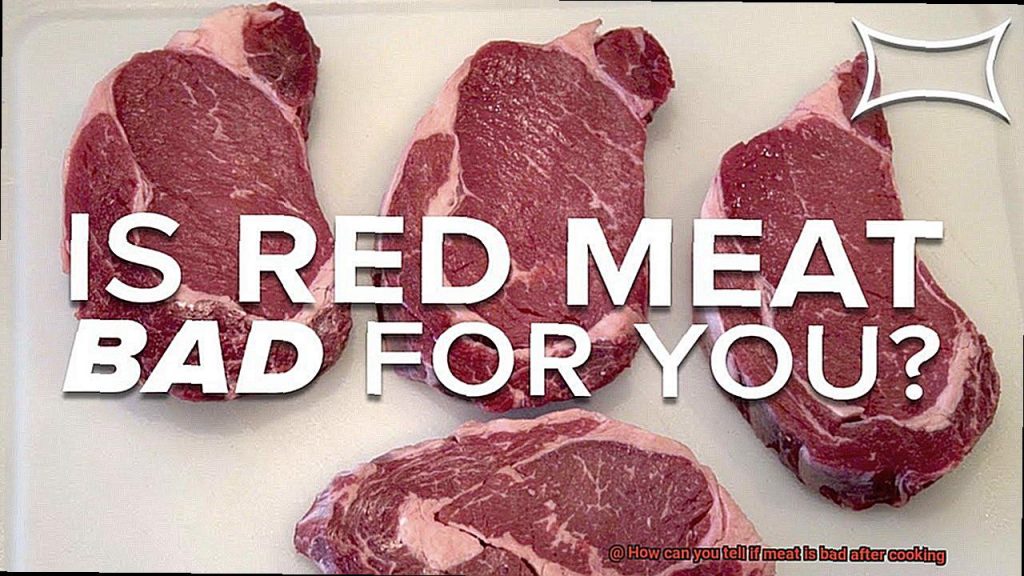Do you know the feeling of a delicious meal turning into a nightmare because of expired meat? It’s an experience that many of us have had, and it can lead to serious health issues like food poisoning or stomach problems. But how can you tell if meat is bad after cooking? This question remains a mystery for most people.
It’s important to remember that cooking doesn’t always guarantee cleanliness, and some bacteria can survive high temperatures and continue to thrive on the cooked surface. So how do you know if your cooked meat is safe to eat? One tell-tale sign is the smell. If it smells sour or rotten, it’s best to throw it away. The texture can also be an indicator – slimy or sticky meat is a no-go. And don’t forget about color – any significant change could suggest spoilage.
In this blog post, we’ll dive deeper into the topic and provide you with a comprehensive guide on how to tell if meat is bad after cooking. You’ll learn to trust your senses and identify warning signs that indicate caution when consuming meat. After all, food safety matters to all of us, and it’s better to be safe than sorry. Let’s explore the world of meat scrutiny together.
Contents
Signs of Spoiled Meat After Cooking
While some bacteria and pathogens may not produce any noticeable changes in the meat’s appearance or smell, there are several signs that you can look for to determine if the meat is still safe to eat or if it has gone bad.
The first and most obvious sign of spoiled meat is its foul odor. If the meat has a strong, unpleasant smell that is noticeably different from its usual scent, it is likely spoiled. Additionally, if the meat has a slimy or sticky texture, this can also indicate spoilage.
Another indicator of spoiled meat is discoloration. If the meat has a greenish tint or dark spots on its surface, this could be a sign of bacterial growth. Similarly, if the meat has a grayish-brown color or appears dull and dry, it may no longer be safe to consume.
It’s important to note that sometimes these signs may not be present. Therefore, practicing proper food safety measures when handling and storing meat is crucial. Cooking the meat to the appropriate temperature and refrigerating or freezing it promptly after use are just some ways to ensure that your food stays fresh for longer.
In addition to these signs, here are some other red flags to keep in mind:
- If the packaging has an unusual amount of air in it
- If there are tears or holes in the packaging
- If the meat has been left at room temperature for an extended period of time
a. Unpleasant Odor
That smell is not just your imagination – it’s a telltale sign that your meat has gone bad and should not be consumed.
The cause of this foul odor is the breakdown of proteins in the meat by bacteria and other microorganisms. As these microorganisms grow and multiply, they produce chemicals and compounds that give off the characteristic scent of spoiled meat. This odor can range from a slightly sour scent to a putrid and rotten smell that will make your stomach turn.
It’s important to note that not all spoilage bacteria produce an odor, so just because your meat doesn’t smell bad doesn’t necessarily mean it’s safe to eat. However, if you detect an unpleasant odor coming from your cooked meat, it’s best to err on the side of caution and discard it. Consuming spoiled meat can lead to food poisoning, which can cause symptoms such as nausea, vomiting, diarrhea, and stomach cramps. In severe cases, food poisoning can require hospitalization and even be life-threatening.
But what if you’re unsure whether the odor coming from your cooked meat is normal or not? Some types of meat have a stronger odor than others even when they’re fresh. For example, game meats like venison and wild boar can have a slightly musky scent that may be mistaken for spoilage. To play it safe, it’s always better to throw out any meat that smells even slightly off.
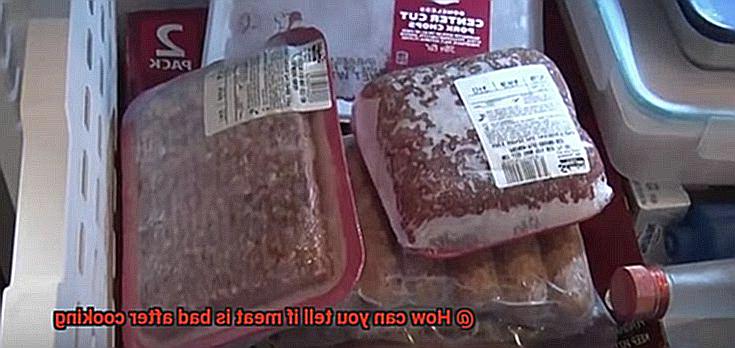
To ensure that your meat stays fresh for as long as possible, make sure to store it properly in the fridge or freezer. Keep raw meat separate from other foods and use it within its recommended time frame. And always cook your meat thoroughly before eating to kill any harmful bacteria.
Slimy or Sticky Texture
A slimy or sticky texture could be a red flag that your meat has gone bad. As an expert on this topic, let me guide you through the science behind this phenomenon.
When meat begins to spoil, it breaks down and bacteria and other microorganisms grow rapidly. This process creates a slimy or sticky film on the surface of the meat, which can make it feel unpleasantly slick or gummy to the touch.
However, not all slimy or sticky meat is bad. Some types of fish, like salmon and eel, have naturally slimy textures even when fresh. It’s essential to identify the type of meat before jumping to conclusions.
To determine if your meat has gone bad, perform a simple touch test with your fingers or utensils. If the meat feels slimy or sticky, it’s best to err on the side of caution and discard it. Trust your senses – they are often right.
Luckily, there are ways to prevent your meat from developing a slimy or sticky texture. Proper storage and cooking are crucial steps to ensure that your meat stays fresh and safe for consumption. Store your meat in the refrigerator or freezer at the appropriate temperature and cook it thoroughly to kill any harmful bacteria that may be present.
Discoloration
Discoloration is one of the most obvious signs that something is off with your meat, so it’s important to pay close attention to any changes in color or appearance.
When meat starts to go bad, it can change color in a few different ways. Cooked chicken that should be white or light pink might appear grey or dull instead. Similarly, beef that should be red or pink might start to look brown or green. These changes in color are a clear indication that something is not quite right with your meat.
Discoloration occurs when bacteria start to grow on the surface or inside of your meat. This can happen when meat is not stored properly or when it’s left out at room temperature for too long. Bacteria can cause the meat to break down and produce a variety of chemicals and substances that change its appearance and texture.
In some cases, discoloration may be accompanied by other signs of spoilage like an unpleasant odor or a slimy texture. However, this isn’t always the case. That’s why it’s important to trust your senses and err on the side of caution if you suspect that your cooked meat might be spoiled due to discoloration.
To ensure that your meat stays fresh and safe for consumption, follow these tips:
- Store meat at the proper temperature: refrigerate at 40°F or below, freeze at 0°F or below.
- Cook meat thoroughly: use a food thermometer to make sure the internal temperature reaches the recommended safe temperature.
- Use leftovers within 3-4 days: discard any leftovers that have been in the refrigerator for longer than 4 days.
Mold Growth
It’s important to know that mold growth on your meat is a definite sign that it has gone bad. Mold is a type of fungus that thrives in warm, moist, and dark environments – making meat a perfect breeding ground. You can easily spot mold growth on meat by looking for fuzzy or greenish-gray patches on the surface or inside the meat. Not exactly appetizing, right?
But moldy meat isn’t just unappealing – consuming it can lead to a host of health problems, including allergic reactions, respiratory issues, and even neurological problems. That’s why it’s crucial to discard any meat that has mold growth on it.
So how do you prevent mold growth on your meat? Proper storage and handling are key. Here are some tips to keep in mind:
- Keep your meat at a temperature below 40°F to prevent bacteria and mold from growing.
- If you’re not planning on using your meat immediately, store it in the freezer until you’re ready to cook it.
- Use fresh meat within a few days of purchase to minimize the risk of mold growth.
- Don’t leave cooked meat at room temperature for more than two hours.
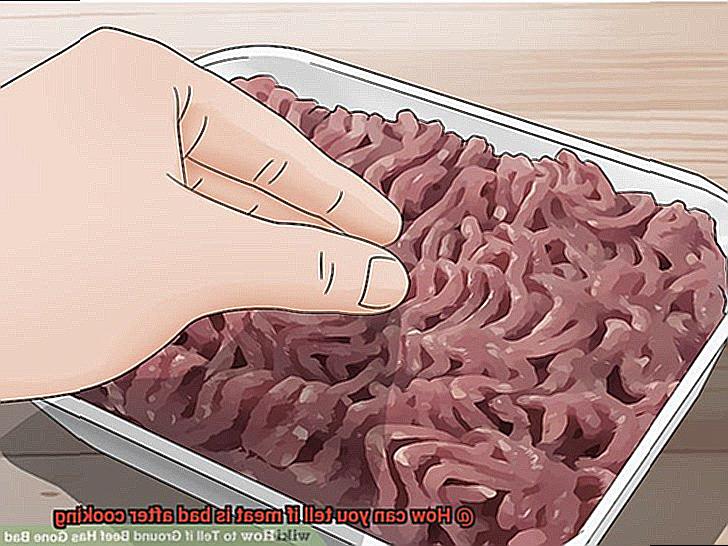
If you’re not sure whether your meat is still good, trust your senses – if it looks or smells off, it’s better to be safe than sorry.
Steps to Take When in Doubt
Cooking meat is an art form, but it’s also crucial to know when meat is safe to eat. In some cases, you may have doubts about the safety of your cooked meat. But don’t worry, there are steps you can take when in doubt.
Firstly, trust your senses. Take a deep sniff of the meat and look for any discoloration or unusual texture. If it smells off, has a slimy texture, or is discolored, then it’s likely that the meat has gone bad and should be discarded immediately.
If you’re still not certain, try using a food thermometer to check the internal temperature of the meat. Cooked meat should have an internal temperature of at least 145 degrees Fahrenheit for beef, pork, veal, and lamb, and 165 degrees Fahrenheit for poultry. If the temperature is lower than this, it may not be safe to eat.
Another vital step is to check the expiration date on the packaging. Even if the meat looks and smells good, if it’s past its expiration date, it should be thrown out. Bacteria can grow over time even in refrigerated or frozen meat.
Lastly, ensure that you’re following safe food handling practices when cooking and storing meat. Wash your hands and surfaces thoroughly before and after handling raw meat, store meat in the refrigerator or freezer promptly after purchase or use, and cook meat to the appropriate temperature to kill any potential bacteria.
To sum up, these are the crucial steps to take when in doubt about the safety of your cooked meat:
- Use your senses
- Use a food thermometer
- Check the expiration date
- Follow safe food handling practices
Proper Storage and Handling Tips for Meat
Ensuring proper storage and handling of meat is not just a matter of taste but more importantly, safety. Here are five sub-sections of tips you should follow to keep your meat fresh and safe to eat.
Maintain the Right Temperature
Temperature is a critical factor in preventing harmful bacteria growth. Meat should be stored at or below 40°F. If you’re not planning on cooking it soon, freeze it until you’re ready to use it. Always defrost frozen meat in the refrigerator to prevent bacterial growth.
Wrap Meat Tightly Before Freezing
Freezer burn can significantly affect the quality of your meat, making it dry and tasteless. To avoid this, wrap your meat tightly in plastic or aluminum foil before freezing it. Additionally, label the package with the date so that you can keep track of how long it has been stored.
Practice Good Hygiene Practices
When handling raw meat, always practice good hygiene. Wash your hands thoroughly with soap and water before and after handling meat, as well as any utensils or surfaces that come into contact with raw meat. Cross-contamination can occur if you use the same cutting board or knife for raw meat and other foods, so it’s essential to use separate tools for each type of food.
Let Your Meat Rest Before Cutting It
After cooking your meat, let it rest for a few minutes before cutting into it. This allows the juices to redistribute throughout the meat, making it more flavorful and tender. However, if you notice any off-putting smells or sliminess on the surface of the meat, these are signs that it may have gone bad and should be discarded immediately.
Check for Signs of Spoilage
If you’re in doubt about the freshness of your meat, always err on the side of caution and throw it away. Some signs of spoilage include a sour or ammonia-like smell, slimy texture, or green or blue spots on the meat. These are all indicators that the meat is no longer safe to eat.
The Importance of Food Safety and Sanitation Practices
Food safety and sanitation practices are crucial, especially when it comes to meat. Poor sanitation practices can lead to food contamination, which can cause serious illnesses. Here’s what you need to know to keep your meals safe and healthy.
Firstly, hand hygiene is key. Always wash your hands thoroughly before and after handling meat to prevent the transfer of bacteria from your hands to the meat. It’s also vital to keep your work area clean and sanitized at all times. Make sure your cutting boards and utensils are washed with hot, soapy water.
When cooking meat, using a food thermometer to check the internal temperature is crucial. This helps ensure that any harmful bacteria are eliminated. Remember to allow the meat to rest for a few minutes after cooking, allowing the temperature to continue rising and ensuring that any remaining bacteria are killed.
Proper storage is another crucial component of food safety. Meat should be stored in the refrigerator or freezer and cooked or frozen within a few days of purchase. Leftovers should be refrigerated promptly and consumed within a few days.
To sum it up, here’s a quick checklist:
- Wash your hands before and after handling meat
- Keep your work area clean and sanitized
- Use a food thermometer when cooking meat
- Allow meat to rest for a few minutes after cooking
- Store meat in the refrigerator or freezer
- Consume leftovers within a few days
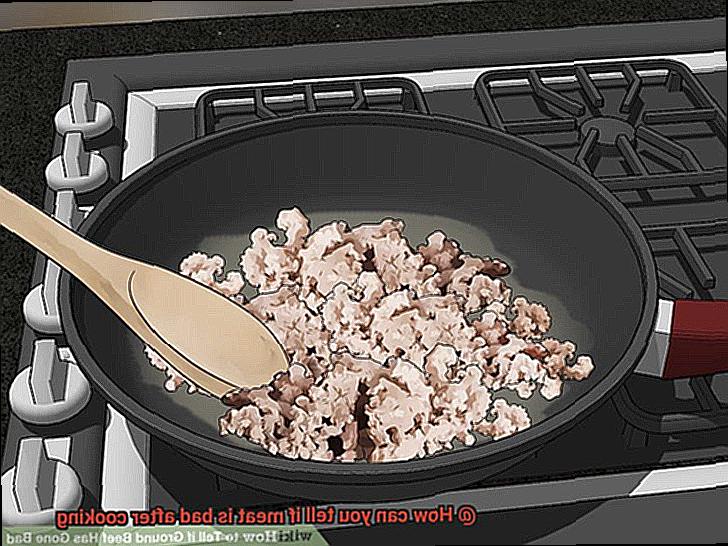
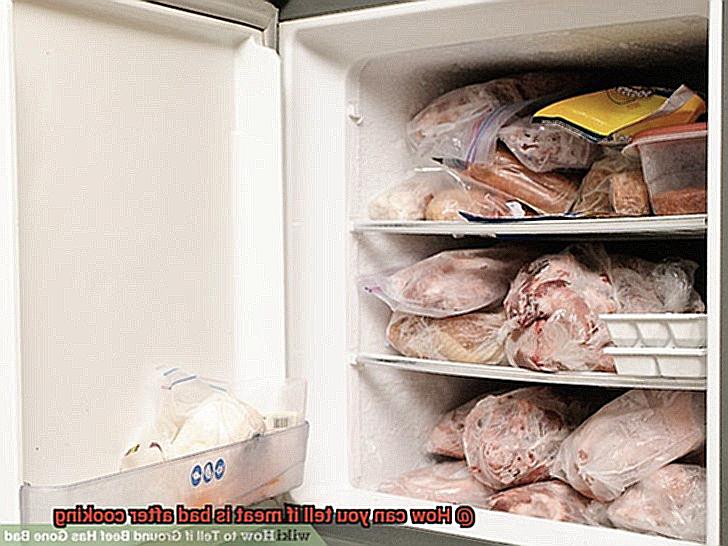
Common Causes of Spoiled Meat After Cooking
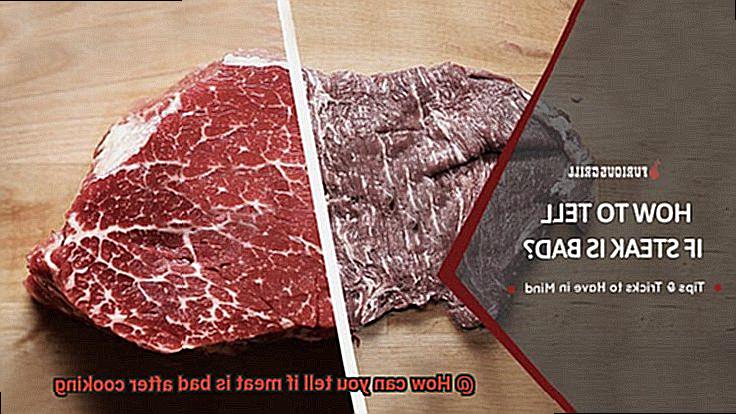
Imagine cooking up your favorite meat dish, only to discover that it’s spoiled. The taste is off, the texture is strange, and it smells bad. What went wrong? As an expert on the topic, I can tell you that there are several common causes of spoiled meat after cooking.
Firstly, bacterial growth can occur even after cooking. Although cooking kills most bacteria, some can still survive on cooked meat and continue to grow at room temperature. This can lead to spoilage and cause foodborne illnesses. Therefore, it’s crucial to store cooked meat properly and consume it within a few days.
Cross-contamination is another culprit of spoiled meat after cooking. If your cooked meat comes into contact with raw meat or other contaminated surfaces like cutting boards or utensils, it can cause cross-contamination. This can lead to the growth of harmful bacteria and spoilage.
Improper storage is another common cause of spoiled meat after cooking. Meat should always be stored in the refrigerator or freezer at the appropriate temperature to prevent spoilage. Leaving cooked meat at room temperature for too long can lead to bacterial growth and spoilage.
Overcooking or undercooking meat can also lead to spoilage. Overcooked meat becomes dry and tough, making it more susceptible to spoilage. On the other hand, undercooked meat can contain harmful bacteria that can cause spoilage and foodborne illnesses.
To ensure safe consumption of meat, proper handling, storage, and cooking techniques are essential. Always wash your hands, keep your work area clean, use a food thermometer to check the temperature of the meat, let it rest for a few minutes after cooking, store it properly, and consume leftovers within a few days.
How to Prevent Spoilage of Cooked Meat
There are several steps you can take to prevent spoilage and avoid foodborne illness, so let’s dive into them now.
Proper storage
After cooking meat, it’s crucial to store it immediately and appropriately. Meat should be placed in an airtight container and stored in the refrigerator or freezer at the appropriate temperature. If you’re not going to eat the meat right away, let it cool down to room temperature before storing it. Leaving cooked meat at room temperature for more than two hours can allow bacteria to grow, which can lead to spoilage.
Thorough cooking
Ensuring that meat is cooked thoroughly is critical to kill any bacteria that may cause spoilage. Different types of meat require different temperatures, so use a meat thermometer to check the internal temperature of the meat. For instance, ground beef should be cooked to an internal temperature of 160°F (71°C), while chicken should be cooked to 165°F (74°C).
Proper hygiene
Proper hygiene and cleanliness are essential when handling and preparing meat. Wash your hands thoroughly with soap and water before and after handling meat, and use separate cutting boards and utensils for raw and cooked meat to prevent cross-contamination. This will help prevent bacteria from spreading, which can lead to spoilage.
Use-by date
Before cooking meat, always check the use-by date. Meat that is close to its use-by date should be cooked immediately or frozen for later use. Consuming meat past its use-by date increases the risk of spoilage and foodborne illness.
Avoid cross-contamination
Cross-contamination occurs when bacteria from raw meat spreads to other foods or surfaces. Prevent this by using separate cutting boards, utensils, and dishes for raw and cooked meats. This will help prevent bacteria from spreading, which can lead to spoilage.
What to Do if You Suspect Food Poisoning from Eating Spoiled Meat
It’s important to take immediate action to prevent further complications. Here are five steps you can take:
Stop eating the meat immediately
If you suspect that the meat is contaminated, do not try to salvage any leftovers or cook it further. Put it in a sealed container and dispose of it properly. This can prevent the spread of contamination to other foods.
Stay hydrated
One of the main risks of food poisoning is dehydration, which can worsen your symptoms. Drink plenty of fluids like water, clear broths, or electrolyte beverages to stay hydrated. Avoid alcohol and caffeine as they can further dehydrate you.
Seek medical attention
If your symptoms are severe or last longer than a few days, it is crucial to seek medical attention. Your doctor may prescribe antibiotics or other medications to help alleviate your symptoms and prevent complications.
Dispose of contaminated food
To prevent further spread of contamination, throw away the meat and any other food that may have come into contact with it, such as utensils or cutting boards. Afterward, clean and sanitize any surfaces that may have come into contact with the contaminated food.
Contact the establishment
If you suspect that the meat was purchased from a store or restaurant, contact the establishment and report your symptoms to the appropriate authorities. This can help prevent others from getting sick and allow for proper investigation of the source of the contamination.
Furthermore, taking steps to prevent food poisoning in the future is key. Properly store and cook meat, avoid cross-contamination between raw and cooked foods, and wash your hands thoroughly before and after handling food. By taking these precautions, you can reduce your risk of getting sick from contaminated food in the future.
XSVTNUBteMg” >
Conclusion
Determining if meat is bad after cooking is a crucial skill to have in the kitchen.
While some signs of spoilage may be obvious, such as a foul odor or slimy texture, others may be more subtle and require a closer inspection. It’s important to remember that consuming spoiled meat can lead to foodborne illness, which can cause serious health problems.
By following proper storage and cooking techniques, regularly checking expiration dates, and using your senses to assess the quality of the meat, you can ensure that you’re serving safe and delicious meals every time.

